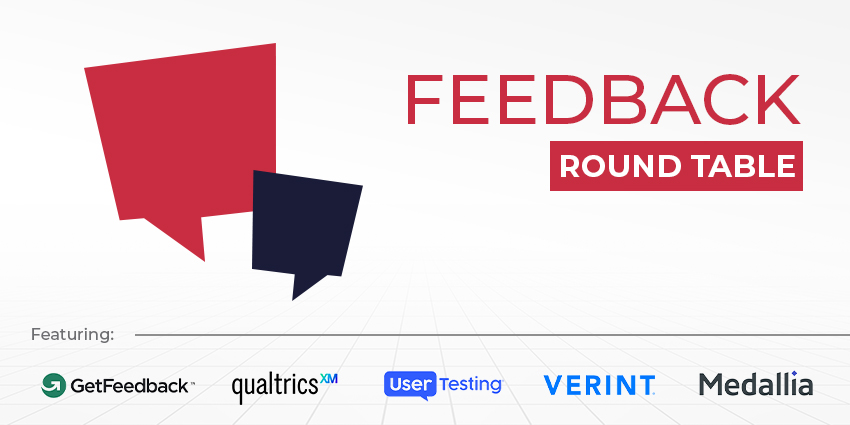Having a great customer experience is useful for many things, one of which being that if the experience is good, customers will continue to use products and services. But how can organisations know if their products and services are good or bad without risking losing customers? By collecting feedback, organisations can figure out exactly what they are doing right (and wrong). More often than not, employee experience is closely tied to customer experience, as great employee experience usually leads to many great customer experiences.
In this edition of the CX Today round table, we welcome:
- Graham Douglas, Head of GetFeedback in EMEA at Momentive
- Aimee Lucas, Director, CX Center of Excellence, Qualtrics
- Janelle Estes, Chief Insights Officer, UserTesting
- Eric Head, VP, Experience Leadership, Verint
- Melissa Arronte, Solution Principal of Employee Experience, Medallia
Our panellists will discuss how technology still faces issues in the areas of improvement in EX, unlocking feedback in the next generation of CX and the difference between structured and unstructured feedback and how they provide valuable insights to EX and CX.
Why are there technologies available to help identify areas of improvement in EX, yet issues highlighted are rarely remedied by some businesses?

Douglas: “In a nutshell, EX technology exists to improve the bottom line. The employee journey is an opportunity to find, hire, train, and engage with employees who are willing and able to deliver on your customer experience in the best possible ways. Disengaged employees are less productive, increase turnover, and are less likely to go the extra mile for their teams and customers. That is why EX is a critical area that businesses should proactively try to improve upon, and yet, many fail to measure and act upon employee feedback.
While there are many solutions available that can measure employee experience and provide actionable insights, businesses often lack the time or resources to make those improvements, or aren’t convinced of the necessity. That is why it is important for businesses to gather insights from employees at every stage of the journey — from interviewing, to onboarding, regular intervals throughout employment, and during offboarding. Employee engagement surveys, Employee Net Promoter Score® (ENPS) Surveys, Employee Performance Review Surveys, and Management Performance Review Surveys are ways to collect feedback and measure key EX metrics.
When businesses take more time to measure their EX efforts and improve, this investment will improve the customer experience, too.”
Lucas: “Technology can absolutely be a useful tool to capture, analyze, and distribute feedback that highlights what is working and not working when it comes to an organization’s employee experience (EX). But identifying what’s not working is only the first step; to improve EX, people at the organization need to do a combination of things. They need to discuss and diagnose root causes, they need to believe that investing in improving EX is important, and they need to commit to taking action and then hold the organization accountable to change.
And while in some instances, EX improvements can be accomplished within the HR team alone, most EX improvements require employees outside HR to create the most impact – senior leaders, people managers, individual contributors, frontline employees.
As the need to change extends to audiences beyond HR, there are headwinds that may make progress or achieving success more difficult, such as competing organizational priorities, a lack of knowledge or ability to adopt a new behavior, struggles with demonstrating those behaviors consistently in a virtual or hybrid work environment – just to to name a few.”
Estes: “Companies are starting to understand the true influence employee experience (EX) has on customer experience; it is undeniable that a culture of engaged, invested, and happy employees strengthens the overall customer experience and in turn–the company’s performance. Because employee experience has a direct correlation to the customer experience and a company’s bottom line, technologies to improve it have proliferated. Companies are rethinking how they approach traditional human resources practices with a renewed focus on the employee and workplace experience.”
Head: “Technologies help identify areas of improvement in EX, but most organizations don’t have the ability to unify all their disparate data sources. Organizations are often siloed, and each department may approach gathering the data and metrics differently. To remedy customer issues and identify root causes, you must take a unified approach with all the interaction data. With a unified view of customer data, you know what customers are saying and expecting across all channels. Data can come from surveys, open-ended questions, call recordings, speech and text analytics, chats, IVA conversations, and more. CX departments must understand what drives people in the moment to contact the organization, depending on the channel they are using. Having this knowledge helps organizations design the best CX.
Another reason CX issues don’t get resolved is the lack of a truly balanced customer scorecard. For example, when organizations are assessing agent performance, they gather a variety of metrics to ensure customer satisfaction. Not all CX metrics take into consideration other valuable insights such as complexity of the interaction or empathy for the customer situation. Using a balanced scorecard enables organizations to gather a variety of metrics and assess these areas collectively.”
Arronte: “Employee Experience leaders have expanded beyond annual engagement surveys, adding the ability to continuously listen to a much wider set of experience signals. Employees are constantly signaling how they feel on the job, what their challenges are, and how they can be supported — all without responding to a single survey.
Technology can capture these indirect signals, and when combined with survey results, they tell the story of employee experience in real-time. Successful programs are always-on and capture feedback and signals at key moments for the company (i.e. recruitment, onboarding, training), for the employee (job transfer, new manager, etc.), and in the flow of work (i.e. process improvements, crowdsourcing ideas, etc.).
But, gathering signals is just the start. Next, organizations must determine how to remedy issues highlighted. Organizations need to make data gathered accessible to stakeholders with the knowledge and ability to act. Start by getting alignment on experience priorities and KPIs. This will help direct which data and signals you should focus on to identify trends. Organizations that continuously listen, understand, and respond to employees will achieve their experience goals – improving retention, increasing productivity, and enhancing engagement.”
How can feedback unlock the next generation of CX?
Douglas: “Customer experience is a never-ending journey to gather feedback across the customer journey, align the cross-functional resources to take action on what matters most, and measure the business impact of those improvements.
However, while many marketers and CX professionals already recognise the value and importance of customer feedback, many are unable to handle unstructured data which is key to building impactful brand experiences and the next generation of CX. Unstructured data includes difficult-to-measure information like informal social media posts made by customers, which can often include invaluable information.
As more and more consumers interact with brands across various touch points across the customer journey, from social media to in-store and everywhere in between, it’s important for businesses to be able to analyse and collate this unstructured data. The businesses who are able to do so in an agile, seamless way will unlock the next generation of CX.”

Lucas: “In terms of using feedback to define an organization’s future customer experience (CX), there are two powerful sources of insights to tap – customers and employees. When focusing on CX, feedback from customers – from survey responses to online reviews – is the natural starting point as it provides a direct perspective of how the organization meets, or doesn’t meet, expectations. This feedback should be purposefully collected, analyzed and, most importantly, acted upon in order to rapidly adapt the business to align with customers’ expectations and needs.
Employees are an overlooked source of insights when it comes to how to improve CX – an insight gap that organizations should work to close. When gathered in the context of better understanding CX, employee feedback can identify ineffective processes and policies, outdated systems and tools, missing skills, or other barriers that impact employees’ ability to effectively serve customers. Employees can also channel the voice of the customer into the organization – conveying what’s delighting or frustrating customers. Organizations just need to ask for it, including providing easy ways for employees to share their feedback and then closing the loop with employees by sharing what actions the organization is taking based on employee feedback.”
Estes: “When you can get a vivid, first-person perspective of how your customers and target audiences react, feel, and interact with any and every touchpoint your company provides, the impact is invaluable. This type of perspective drives immediate action and change across the organization. The power of putting yourself in the shoes of your customers and being able to see the world through their eyes helps you understand your customers as humans, not data points, and that is the type of feedback that will unlock the next generation of CX.”
Head: “The next generation of CX goes beyond measuring NPS, or other metrics after the fact. It’s about impacting CX during the interaction. This is where real-time agent assist comes into play by monitoring negative or positive sentiment, complaints escalations, and even interruptions and long silences. If those situations are detected during a phone conversation, the agent can get a nudge from the work assist application residing on the agent’s desktop. In the case of escalation, it could also alert a supervisor or manager, customer retention officer, or compliance officer. The AI-driven real-time agent guidance and support from a senior manager when needed can lead to better interaction outcomes and improved CX. Measuring CX after the fact is still important and can be used to build predictive models and longer-term initiatives but impacting CX immediately requires real-time guidance.”

Arronte: “Understanding customer needs and expectations has always been at the heart of customer experience. But for many companies, customer feedback (like employee feedback) has come primarily from surveys. Surveys look at the past. Signals capture the present, and power the future.
In today’s digital-first world, companies must combine feedback from surveys with feedback captured from experience signals in real time across the entire customer journey.
Signals are customer experience data points that come from different systems, channels, in-house technology, and even third-party sources. Signal types include digital clickstream data, e-commerce information, POS data, call center interactions, CRM data, service interactions, IoT data, HR data, sentiment captured from videos, sales and marketing tools, and yes, even survey data.
By listening to and learning from all the signals customers send, companies can not only improve experiences in the moment, but also learn how to stay in front of the customer and ahead of the competition. Done right, customer experience delivers tangible business impact — driving loyalty, reducing churn, and growing revenue.”
What’s the difference between structured and unstructured feedback and how can each provide valuable insights into CX and EX?
Douglas: “Data exists in different forms, most commonly thought of as either structured or unstructured data. Businesses who want to improve their CX and EX program should invest in both.
Structured data is anything you can tie a hard number to. This includes closed-ended questions, like yes/no questions.
Unstructured data is simply everything that’s not structured data. This includes answers to open-ended questions in a survey or social media comments.
When analyzing customer insight, it’s nice to have clean, consistent data. However, customers are only able to articulate so much on a rating scale — you need more information to understand the “why.” There needs to be more than just hard numbers to truly understand customer sentiment and take the right actions.
Looking into unstructured data gives you insight into how someone is feeling. The process of mining unstructured data depends on your resources. Text analysis tools are becoming more common as a way to use machine learning to automatically uncover the trends and sentiments contained in customer feedback. If you aren’t using machine learning or AI, you’ll need to dig through the data manually, which can quickly become overwhelming as your CX programme matures.”
Lucas: “Structured feedback is typically solicited through surveys and is quantitative in nature. It is reported as a score or a percentage and helpful in measuring progress towards a goal or to benchmark performance.
Structured feedback includes everything from a customer satisfaction score to how employees rate an online learning course. While structured X-data is easy to present and explain, organizations only learn about this feedback when they ask questions to those who then choose to answer them.
Unstructured feedback may come in through surveys in the form of open-ended questions inviting someone to “tell us more,” and also can be collected through ambient channels. Reviews on employer rating sites, customer service interactions, or social media also fall into this category. Unstructured data requires more analytics to identify the performance and sentiment patterns that yield actionable insights to inform continuous improvement efforts. This data helps organizations detect problems, opportunities, and even strengths that are not captured through the questions asked in structured mechanisms.
Unstructured data also unlocks an understanding of how organizations’ experiences are making their customers or employees feel. Emotions matter when it comes to designing and improving experiences as they directly impact engagement and loyalty. Qualtrics XM Institute research shows that emotion is an aspect that is typically neglected in experience measurement, and unstructured data analysis is one place to start for organizations to understand the experiences of their customers and employees and build organizational empathy.”
Estes: “I like to say marrying structured feedback, such as analytics and certain types of survey feedback, with unstructured feedback, such as making a connection with your customer or employee via direct observation or even a conversation, gives you a 360 degree view.
Structured feedback tells you what your customers and employees are doing and even how they feel about it, while unstructured feedback helps you understand why they are doing certain things and how you can improve the experiences you provide. Having access to both of these data sets are powerful tools for organizations looking to bring the voice of their customers and employees into their decision making process.”

Head: “Both structured and unstructured feedback play an important role in CX programs. Direct feedback through surveys, websites, or post-call surveys can provide structure to the program and allow organizations to generate KPIs including net promoter and CSAT scores. This direct feedback from customers also allows for the ability to trend metrics over time and conduct comparative benchmarking analysis. Also, once CX improvements are put into effect, the structured KPIs can demonstrate the effectiveness of these initiatives.
Unstructured feedback allows for further analysis into the root cause of an issue. This can come from many forms, including social media, online forums and communities, blogs, open-ended survey questions, call transcripts, emails, and other sources. The unstructured data provides the opportunities for in-depth analysis and insights so an organization can act on this valuable data.”
Arronte: “Feedback is actually only one piece of the puzzle. To get the total view, organizations should think more broadly about employee signals, the indicators of what your employees have to say — and how they feel — about your company. These signals can be gathered from direct inputs, such as feedback surveys, or indirect sources, such as PTO patterns, usage of systems and tools, and more.
When combined, these sources of data can reveal the full picture of your employee experience in real time, providing an in-the-moment pulse of how your people are really doing.
For example, starting right on an employee’s first day, there are a variety of employee experience signals that your organization can begin tracking throughout the employee onboarding journey, such as engagement with onboarding materials or benefits enrollment. Tracking from day one can help with improving compliance, strengthening role clarity, fostering connections, and empowering new hires to embrace and embody your company’s culture. Optimizing the onboarding experience by harnessing key signals has a significant, measurable impact on how quickly new hires get up to speed, how well they perform, and how long they stay with your organization.”







